 |
||
|
||
| ||
 The aim of a tester which examines a new chip or a card is to show its capabilities, estimate it and... forget about it until the next card. Our objective is deeper as apart from separate reviews we have the 3Digest where not just one card but a certain trademark gets an overview. Besides, there is a concept of rating which also takes into account prices. And now, when GeForce4 MX 440 based video cards appeared on the shelves, it's interesting to find out how competitive they are in comparison to old products and which cards they are going to fight against. Traditionally, we start a new cycle of reviews of GeForce4 MX based video cards. Theoretical materials and reviews of video cards which concern functional properties of the NVIDIA GeForce4 MX GPU Today we are going to take a look at 4 production video cards based on the GeForce4 MX 440. The MX 440 appeared first as a prime cost of such cards is even lower than that of GeForce2 Ti, and at the same time they are better in speed and sometimes in functions. Therefore, the MX 440 is an excellent choice to replace the aging GeForce2 Pro/Ti line. The GeForce4 MX 460 is a more expensive solution, first of all, because of the memory (3.6ns, BGA package). It is positioned as a competitor against the GeForce3 Ti 200. Besides, the competition of GeForce4 MX 460 vs GeForce3 Ti 200 is ambiguous as the former can outperform the latter but it doesn't have a full support of the DirectX 8.0. It's not an important downside as there are not many games using the shader technology. However, it prevents the spread of DirectX 8.0 games into the mainstream sector. Nevertheless, the new MX 440 based cards are already glutting the market. And they are cheaper than the GeForce2 Ti cards were in the beginning. So, now let's turn to the video cards from ABIT, ASUS, Leadtek and Prolink. CardsLeadtek WinFast A170V DDR THThe Leadtek WinFast A170V DDR TH has an AGP x2/x4 interface, 64 MBytes DDR SDRAM located in 4 chips on both sides of the PCB.    Leadtek equipped the card with a faster than required memory of 4ns (Samsung) the rated frequency of which is 250 (500) MHz. But the card operates at 200 (400) MHz according to the NVIDIA recommendations. The GPU works at 270 MHz. The design differs from the reference one only in the hardware monitoring support which the Leadtek's card is equipped with (below you can compare it with the MSI cards based on the reference design). Leadtek WinFast A170V DDR TH  NVIDIA GeForce4 MX 440 reference card  There you can see the Hardware Monitoring in the form of LEDs:  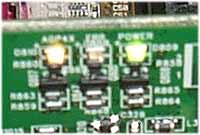  Under the heatsink is a thermo sensor's tail which is pressed against the chips's surface. And there is also a tachometer of the fan. The Hardware Monitoring is controlled by the WinFox 2.0 utility, it works also under the Windows XP:  Apart from hardware monitoring functions 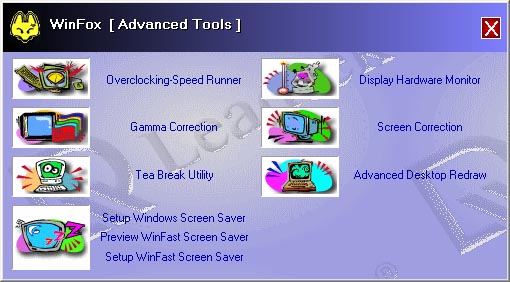 the program allows overclocking the card:  The Philips 7100 video processor located on the left part controls VIVO (VideoIn VideoOut):  The card does support VIVO. It comes with an adapter-splitter which makes possible to connect video signal receivers and sources to the card: 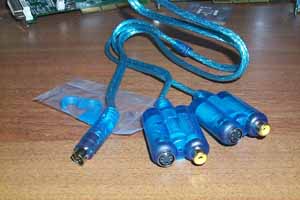 Unfortunately, the card's lacking for software for optimization of the Video In. Usage of the Philips processor implies that the NVIDIA's video capture drivers can be used in this case, and we also need the InterVideo WinCoder program which works the best way with this coder. Every time Leadtek releases a new product it surprises with new unusual cooler designs:   This one is very stylish and rather effective!  Under the heatsink is the GeForce4 MX 440 which is marked as NV17, like on the card of early releases. The TV-out is realized not through the Philips coder, but via the GeForce4 MX's functions (see for details in the GeForce4 Ti review and below in the section of the next card). The Leadtek WinFast A170V DDR TH card has neither the second VGA connector nor DVI, that is why the nView technology will let only to make several virtual desktops.  The card ships in a Retail package which includes:
OverclockingThe Leadtek WinFast A170V DDR TH showed a good overclocking potential - 310/260 (520) MHz. Although the GeForce4 MX has a new memory controller, at such high frequencies (270 MHz and higher) the bandwidth of even the DDR memory working at 200 (400) MHz won't let the GPU enable its entire potential. Note:
 ABIT Siluro GF4 MXThe ABIT Siluro GF4 MX has an AGP x2/x4 interface, 64 MBytes DDR SDRAM located in 4 chips on both sides of the PCB. 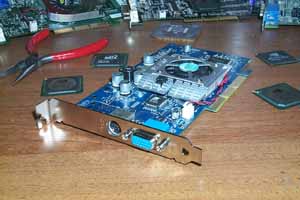 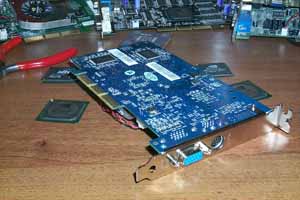 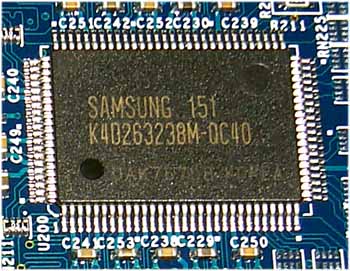 Again, Abit equipped the card with a faster than required memory of 4ns (Samsung) the rated frequency of which is 250 (500) MHz. But the card operates at 200 (400) MHz according to the NVIDIA recommendations. The GPU works at 270 MHz. The ABIT's card follows the NVIDIA's reference design: ABIT Siluro GF4 MX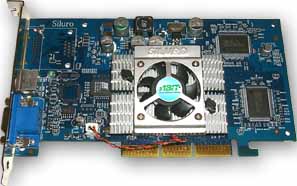  NVIDIA GeForce4 MX 440 reference card  The PCB is sky-blue which is not typical of ABIT. The GPU has a cooler peculiar to the GeForce3 cards from this company.  The ABIT Siluro GF4 MX card has neither the second VGA connector nor DVI, that is why the nView technology will let only to make several virtual desktops. The TV-out is realized without the help of an external video processor. And the TV-out quality is excellent:  The image completely covers the TV screen so that it's not necessary to make any adjustments. But it should be noted that when you enable the TV-out a monitors' image disappears. To use both a monitor and a TV screen you should interchange the primary and the secondary outputs in the settings. ABIT refused traditional cardboard bags and returned to usual Retail packages:  Accessories:
OverclockingThe overclocking level reached by the ABIT Siluro GF4 MX is quite high - 305/260 (520) MHz. Prolink PixelView GeForce4 MX 440The Prolink PixelView GeForce4 MX 440 has an AGP x2/x4 interface, 64 MBytes DDR SDRAM located in 4 chips on both sides of the PCB. 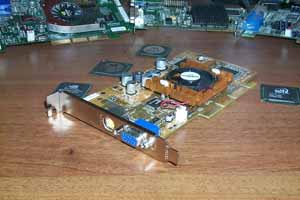   Prolink equipped the card with a faster than required memory of 4ns (Samsung) the rated frequency of which is 250 (500) MHz. But the card operates at 200 (400) MHz according to the NVIDIA recommendations. The GPU works at 275 MHz. The card follows the NVIDIA's reference design: Prolink PixelView GeForce4 MX 440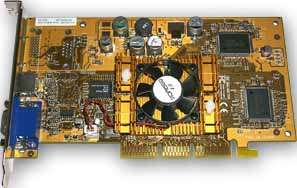 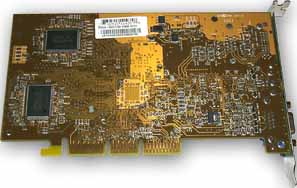 NVIDIA GeForce4 MX 440 reference card  Traditionally, all PixelView video cards including this card are based on yellow PCBs. The cooler's design is ordinary. The lamellar heatsink is quite effective though the GeForce4 MX 440 can do without a fan. Again the card has neither the second VGA connector nor DVI, that is why the nView technology will let only to make several virtual desktops. The card though has seats for it. It's strange to save on such details.  The Retail package contains:
OverclockingThe Prolink PixelView GeForce4 MX 440 has a quite good potential - the GPU was able to reach 320 MHz, though the memory is more decent - only 252 (504) MHz. ASUS AGP-V8170The ASUS AGP-V8170 has an AGP x2/x4 interface, 64 MBytes DDR SDRAM located in 4 chips on both sides of the PCB. 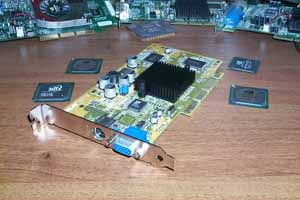 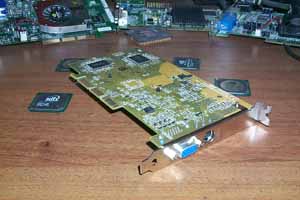 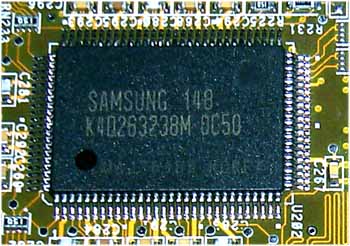 Strangely enough, the card uses 5ns memory, though it corresponds to the --NVIDIA's recommendations (200 (400) MHz). I should say that after the GeForce3 was released almost a year ago and the card outscored its competitors by a great margin in everything, the company withdrew from developing interesting solutions. Its mainstream cards had nothing particular. Its drivers with the company's own settings are now too old, and stability is not brilliant any more. Many users of the Deluxe cards had to use NVIDIA's drivers instead of the ASUS software. This card follows the reference design and doesn't differ from the Prolink one: ASUS AGP-V8170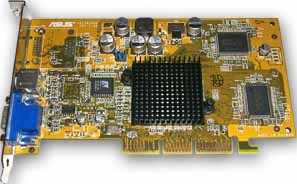 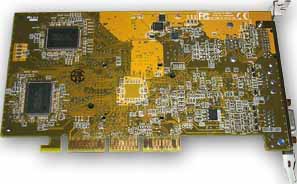 NVIDIA GeForce4 MX 440 reference card  The heatsink has no fan on it: although the GeForce4 MX 440 doesn't warm up considerably, the overclockers will hardly like it. We got the card in the OEM package, though it is going to sell in the Retail one. OverclockingThe GPU reached 310 MHz, and the memory results are much more decent - only 230 (460) MHz, though for 5ns modules it's very good. Well, if one of the two very similar cards has a faster memory and costs cheaper, and the other lacks for a fan, so what will be the choice? Test system and driversTestbed:
The test system was coupled with ViewSonic P810 (21") and ViewSonic P817 (21") monitors. In the tests we used NVIDIA's drivers of v27.30. VSync was off, S3TC was off. For the comparative analyses we used the following cards:
Test resultsThe 2D quality is on the level of the GeForce3 video cards. But bear in mind that 2D quality much depends on a sample of the card and on its friendliness towards a monitor. For estimation of 3D quality we used:
We use few tests because there is our 3Digest where we compare a lot of cards in a great deal of tests. Besides, In the NVIDIA GeForce4 MX review we carried out also many tests. And this time we just compare several production cards. Quake3 ArenaQuaver, High Quality ModesThe test was carried out in 32-bit color mode at the highest detailing level and with complicated geometry (r_subdivisions "1" r_lodCurveError "30000"). This benchmark loads an accelerator with geometry, large textures and huge effects. Usual testing Overclocking All the MX 440 based cards are identical in performance. The frequency higher by 5 MHz didn't help the Prolink PixelView GeForce4 MX 440. The MX 440 turned out to be an unquestioned leader in its price niche ($110-140). The overclocking test shows that while it's worth overclocking the memory, it isn't worth doing it with the processor's core. That is why, when choosing a GeForce2 MX card look, first of all, at the memory it comes with. Return to Castle Wolfenstein (Multiplayer)Checkpoint, High Quality ModesThe tests were carried out in 32-bit color mode at the highest detailing and quality level of textures. Usual testing Overclocking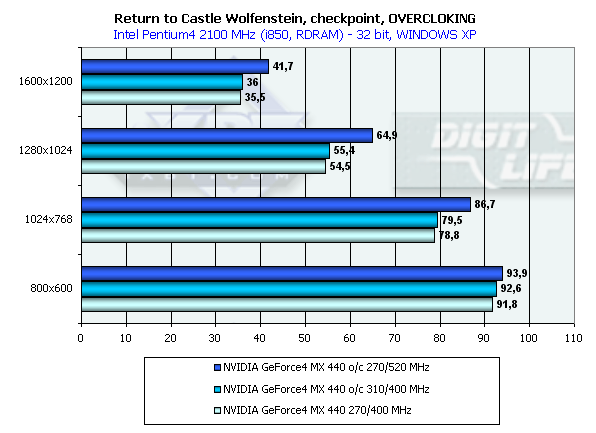 Here the situation is similar except that the RADEON 7500 sometimes beats the GeForce2 Ti card. And the GeForce4 MX 440 is still a champion. In closing, I'd like to advise you to read also other reviews of GeForce3 based video cards. Besides, in our 3Digest you can get thorough information on performance of these cards on different platforms. ConclusionWe examined today 4 production video cards based on the GeForce4 MX 440. Soon we will publish the next review of other GeForce4 MX cards. On the whole, I must say that such an accelerator is a very strong competitor against the ATI RADEON 7500 and a killer of the GeForce2 Ti.
The complete characteristics of video cards of this and other classes can be found in our 3Digest. Highs:
Lows:
Write a comment below. No registration needed!
|
Platform · Video · Multimedia · Mobile · Other || About us & Privacy policy · Twitter · Facebook Copyright © Byrds Research & Publishing, Ltd., 1997–2011. All rights reserved. |